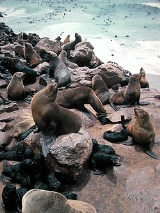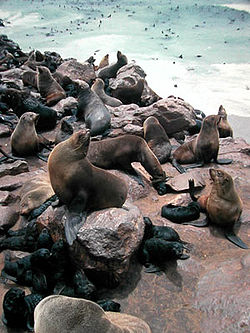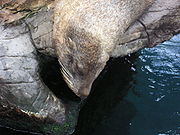
Fur seal
Encyclopedia

Northern Fur Seal
The Northern fur seal is an eared seal found along the north Pacific Ocean, the Bering Sea and the Sea of Okhotsk. It is the largest member of the fur seal subfamily and the only species in the genus Callorhinus.-Physical description:Northern fur seals have extreme sexual dimorphism, with males...
(Callorhinus ursinus) inhabits the North Pacific, while seven species in the Arctocephalus
Arctocephalus
The genus Arctocephalus consists of eight of the nine species of fur seal. For details see the fur seal article, or the individual species articles.-Taxonomy:* SUBORDER PINNIPEDIA* Family Otariidae...
genus are found primarily in the Southern hemisphere. They are much more closely related to sea lions than true seals, and share with them external ears (pinnae), relatively long and muscular foreflippers, and the ability to walk on all fours. They are marked by their dense underfur, which made them a long-time object of commercial hunting
Seal hunting
Seal hunting, or sealing, is the personal or commercial hunting of seals. The hunt is currently practiced in five countries: Canada, where most of the world's seal hunting takes place, Namibia, the Danish region of Greenland, Norway and Russia...
.
Taxonomy
Until recently, fur seals were all grouped under a single subfamily of Pinnipedia called Arctocephalinae to contrast them with Otariinae – the sea lions – based on the most prominent common feature, namely the coat of dense underfur intermixed with guard hairs. Recent genetic evidence, however, suggests that Callorhinus is more closely related to some sea lion species, and the fur seal/sealion subfamily distinction has been eliminated from many taxonomies. Nonetheless, all fur seals have certain features in common: the fur, generally smaller sizes, farther and longer foraging trips, smaller and more abundant prey items and greater sexual dimorphismSexual dimorphism
Sexual dimorphism is a phenotypic difference between males and females of the same species. Examples of such differences include differences in morphology, ornamentation, and behavior.-Examples:-Ornamentation / coloration:...
. For these reasons, the distinction remains useful.
Physical appearance
Fur seals share with other otariids the ability to turn their rear limbs forward and move on all fours. Fur seals are generally smaller than sea lions. At under 1 metres (3.3 ft), the Galapagos fur sealGalapagos Fur Seal
The Galápagos fur seal breeds on the Galápagos Islands in the eastern Pacific, west of mainland Ecuador.- Description :...
is the smallest of all pinnipeds. However, their flipper
Flipper (anatomy)
A flipper is a typically flat limb evolved for movement through water. Various creatures have evolved flippers, for example penguins , cetaceans A flipper is a typically flat limb evolved for movement through water. Various creatures have evolved flippers, for example penguins (also called...
s tend to be proportionately longer, their pelage tends to be darker and the vibrissae
Vibrissae
Vibrissae , or whiskers, are specialized hairs usually employed for tactile sensation. The term may also refer to the thick hairs found inside human nostrils, but these have no sensorial function and only operate as an airborne particulate barrier...
more prominent. Males are often more than five times heavier than the females, making them among the most sexually dimorphic of all mammal groups.
Behavior and ecology

The remainder of the year, fur seals lead a largely pelagic existence in the open sea pursuing their prey wherever it is abundant and plentiful. Fur seals feed on moderately sized fish, squid
Squid
Squid are cephalopods of the order Teuthida, which comprises around 300 species. Like all other cephalopods, squid have a distinct head, bilateral symmetry, a mantle, and arms. Squid, like cuttlefish, have eight arms arranged in pairs and two, usually longer, tentacles...
and krill
Krill
Krill is the common name given to the order Euphausiacea of shrimp-like marine crustaceans. Also known as euphausiids, these small invertebrates are found in all oceans of the world...
. Several species of the southern fur seal also have sea birds, especially penguins, as part of their diet. The fur seals themselves are preyed upon by shark
Shark
Sharks are a type of fish with a full cartilaginous skeleton and a highly streamlined body. The earliest known sharks date from more than 420 million years ago....
s, orcas and occasionally by larger sea lions.
When fur seals were hunted in the late eighteenth and early nineteenth centuries, they hauled out on remote islands where there were no predators. The hunters reported being able to club the unwary animals to death one after another, making the hunt profitable even though the price per seal skin was low.
Exploitation
Many fur seal species were heavily exploited by commercial sealerSeal hunting
Seal hunting, or sealing, is the personal or commercial hunting of seals. The hunt is currently practiced in five countries: Canada, where most of the world's seal hunting takes place, Namibia, the Danish region of Greenland, Norway and Russia...
s, especially during the 19th century when their fur was highly valued. Beginning in the 1790s, the ports of Stonington
Stonington, Connecticut
The Town of Stonington is located in New London County, Connecticut, in the state's southeastern corner. It includes the borough of Stonington, the villages of Pawcatuck, Lords Point, Wequetequock, the eastern halves of the villages of Mystic and Old Mystic...
and New Haven, Connecticut were leaders of the American fur seal trade, which primarily entailed clubbing fur seals to death on uninhabited South Pacific islands, skinning them, and selling the hides in China
China
Chinese civilization may refer to:* China for more general discussion of the country.* Chinese culture* Greater China, the transnational community of ethnic Chinese.* History of China* Sinosphere, the area historically affected by Chinese culture...
. Many populations, notably the Guadalupe fur seal
Guadalupe Fur Seal
The Guadalupe fur seal is one of six members of the fur seal genus Arctocephalus. Sealers reduced the population to just a few dozen by the late 19th century, but the species had recovered to 10,000 in number by the late 1990s...
, northern fur seal
Northern Fur Seal
The Northern fur seal is an eared seal found along the north Pacific Ocean, the Bering Sea and the Sea of Okhotsk. It is the largest member of the fur seal subfamily and the only species in the genus Callorhinus.-Physical description:Northern fur seals have extreme sexual dimorphism, with males...
and Cape fur seal
Cape Fur Seal
The brown fur seal , also known as the Cape fur seal, South African fur seal and the Australian fur seal is a species of fur seal.-Description:...
, suffered dramatic declines and are still recovering. Currently, most species are protected and hunting is mostly limited to subsistence harvest. Globally, most populations can be considered healthy, mostly because they often prefer remote habitats that are relatively inaccessible to humans. Nonetheless, environmental degradation
Environmental degradation
Environmental degradation is the deterioration of the environment through depletion of resources such as air, water and soil; the destruction of ecosystems and the extinction of wildlife...
, competition with fisheries and climate change
Climate change
Climate change is a significant and lasting change in the statistical distribution of weather patterns over periods ranging from decades to millions of years. It may be a change in average weather conditions or the distribution of events around that average...
potentially pose threats to some populations.
Species
- SUBORDER Pinnipedia
- Family Otariidae
- Subfamily Arctocephalinae
- Genus Arctocephalus
- Antarctic fur sealAntarctic Fur SealThe Antarctic fur seal is one of eight seals in the genus Arctocephalus, and one of nine fur seals in the subfamily Arctocephalinae. As its name suggests, the Antarctic fur seal is distributed in Antarctic waters. Around 95% of the world population breeds at the Island of South Georgia...
, A. gazella - Brown fur seal, A. pusillus
- South African fur seal, A. pusillus pusillus
- Australian fur seal, A. pusillus doriferus
- Galápagos fur sealGalapagos Fur SealThe Galápagos fur seal breeds on the Galápagos Islands in the eastern Pacific, west of mainland Ecuador.- Description :...
, A. galapagoensis - Guadalupe fur sealGuadalupe Fur SealThe Guadalupe fur seal is one of six members of the fur seal genus Arctocephalus. Sealers reduced the population to just a few dozen by the late 19th century, but the species had recovered to 10,000 in number by the late 1990s...
, A. townsendi - Juan Fernández fur sealJuan Fernandez Fur SealThe Juan Fernández Fur Seal is a fur seal that breeds on the Juan Fernández Islands off the coast of Chile. It is the second smallest of the otariid seal . Discovered by navigator Juan Fernández in the sixteenth century, the seals became a target for sealers in the Maritime Fur Trade era...
, A. philippii - New Zealand fur sealNew Zealand Fur SealThe Australian fur seal , or New Zealand fur seal or southern fur seal, is a species of fur seal found around the south coast of Australia, the coast of the South Island of New Zealand, and some of the small islands to the south and east of there...
or Southern fur seal, A. forsteri - South American fur sealSouth American Fur SealThe South American Fur Seal is a species of fur seal that breeds on the coasts of Chile and Argentina. The total population is around 250,000....
, A. australis - Subantarctic fur sealSubantarctic Fur SealThe subantarctic fur seal is a fur seal found in the southern parts of the Indian and Atlantic Oceans. It was first described by Gray in 1872 from a specimen recovered in northern Australia—hence the inappropriate tropicalis specific name.- Description :The subantarctic fur seal is...
, A. tropicalis
- Antarctic fur seal
- Genus Callorhinus
- Northern fur sealNorthern Fur SealThe Northern fur seal is an eared seal found along the north Pacific Ocean, the Bering Sea and the Sea of Okhotsk. It is the largest member of the fur seal subfamily and the only species in the genus Callorhinus.-Physical description:Northern fur seals have extreme sexual dimorphism, with males...
, C. ursinus
- Northern fur seal
- Genus Arctocephalus
- Subfamily Otariinae
- Genus Eumetopias
- Genus Neophoca
- Genus Otaria
- Genus Phocarctos
- Genus Zalophus
- Subfamily Arctocephalinae
- Family Phocidae: true seals
- Family OdobenidaeOdobenidaeOdobenidae is a family of Pinnipeds. The only living species is walrus.In the past, however, the group was much more diverse, and includes more than ten fossil genera.- Taxonomy :All genera, except Odobenus, are extinct.*Prototaria...
: Walrus

